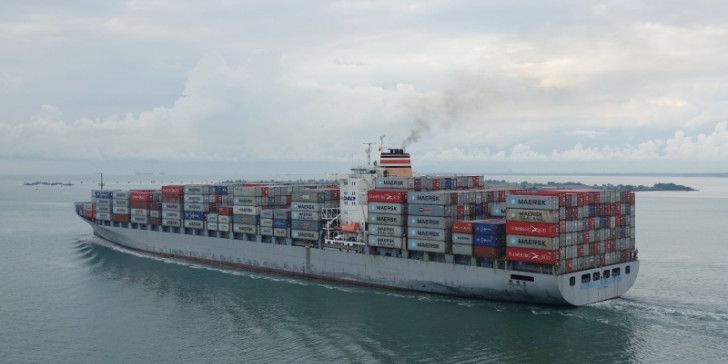Events of global significance and consequences are happening on the world transport market. The coronavirus pandemic has caused a shock on highways, especially at sea and on railways, and this shock has not only not gone away so far, but is even getting worse. Entire industries are suffering enormous damage, and consumers around the world are falling victim to what is happening.
“We expect the market situation to improve no earlier than the first quarter of 2022. If a year ago the probability of your ship arriving on time was 80%, now it is only about 40%,” said the management of the German transport company. Hapag-Lloyd, one of the world’s largest container carriers.
Another shock to global logistics was the sharp rise in the price of services. According to the British company Drewry Shipping, the cost of shipping a standard 40-foot container on 8 of the main routes of the East-West corridor has jumped 360% in the last year and reached almost $ 10,000. And in such a popular destination as Shanghai-Rotterdam , the cost of shipping containers increased by 659%, and reached $ 13,700.
“The current historically high freight rates are caused by unmet demand. It’s just not enough capacity, “said Danish company Maersk, another container giant, in a recent report. The announcement came shortly after a new coronavirus epidemic in China led to further disruptions in global logistics.
In mid-August, the large container terminal at Ningbo Zhoushan Port, south of Shanghai, was closed after one of its workers was diagnosed with coronavirus and leading shipping companies had to urgently adjust their delivery schedules. In June, for the same reason, the port of Yantian north of Hong Kong was closed and reopened within a few days, but the restoration of normal operation of logistics operators continued throughout the summer, as lost capacity had to be urgently compensated by other ports.
Due to congestion in ports and service queues, the average delay of ships is now 7 days, says Irina Yordanskaya, head of foreign economic activity of the distribution company diHouse. In addition, in the last year, the accuracy of the carriers’ schedule has significantly decreased and shipping lines accept shipments for shipment no earlier than 2 weeks after booking.
The other obstacle is the banal lack of containers, adds Petar Nechiporenko, commercial director of the St. Petersburg company Carvil, which supplies auto parts. According to him, this circumstance necessitated a reduction in the number of ships with an increase in demand for transport services, which led to a colossal increase in the price of freight.
The current risks will continue in the coming months, predicts Ekaterina Resnyanskaya, head of the St. Petersburg logistics company Hermes. According to her, this is due to the fact that the need for measures to prevent coronavirus has not disappeared, even despite the progress of vaccination programs in countries actively involved in world trade.
The diversification of cargo flows, the distribution of cargo in a large number of ports still remains a fantastic scenario, says Sergei Safoninkov, a representative of the transport company PEK: GLOBAL. Despite all the problems, he notes, giant ports continue to increase cargo congestion: for example, the container turnover of the world’s largest port, Shanghai, amounts to 26.64 million conditional containers (TEUs) in 7 months, an increase of 11.2% for the year.
Disappointing alternatives
The constant problems of maritime logistics have prompted many customers of transport services to look for new routes – rail, road or air transport. However, even here very narrow places were immediately discovered.
Restrictions on coronavirus in China extend not only to ports but also to road transit, making it even more impossible to predict deliveries. Added to this are force majeure factors such as typhoons, which hit Chinese ports in late July, said Julia Shlenskaya, head of the customs office of KBT Service. The current specificity of the delivery of goods from China to Russia, she said, is that due to the significant reduction in the number of direct trains, many market participants have decided to switch to maritime deliveries, which has increased pressure on the already congested canal.
“Now our customers are waiting for sea delivery from China through the Far East for 50-60 days instead of the usual 30-40 days. And that, as it turned out, is still a good time. “The port infrastructure of the Far East is working at the limit of its capabilities because there is not enough equipment and capacity,” says Shlenskaya.
After the price of freight on the China-Europe sea route through the Suez Canal rose to $ 15,000 per container, many companies actually shifted their cargo to direct express trains, said Stanislav Tobin, head of logistics at Arivist Group. But their routes, the expert admits, were not ready for the sharp increase in freight traffic. Restrictions on coronavirus have been introduced at many checkpoints, which has significantly reduced throughput as well as lost time due to the different track gauge of the Russian and Chinese railways, which requires container handling from platform to platform.
“Before, the volume of traffic was distributed more or less evenly, and in proportion to the capacity of ports and stations,” Tobin recalls of pre-crisis times. – “Now freight flows have started to move sharply, the infrastructure can not cope with this, and the capacity of Vladivostok terminals has reached its limit. The port does not have enough capacity to accommodate the incoming cargo, process it and send it by direct train to Moscow. “
In the road transport segment, the increase in delivery costs is influenced by their own reasons. According to Sergei Potapov, head of logistics at ProfHolod, in Russia tariffs have risen over the past year by an average of 10 to 30%, depending on the directions, but there are segments where growth has reached 100%. The reason for this was the shortage of drivers, the increase in part-time traffic due to the development of e-commerce, the increase in fuel prices, the indexation of tariffs in the Plato system, the elimination of MKAD gaps for transit trucks and the reduction of their number by approximately 20% due to the aging of the fleet. All this does not allow us to rely on the fact that the price of road delivery will fall in price, Potapov concludes.
Deficit as a norm of life
Constant supply problems do not allow us to deal with the shortage of components in many world markets, which leads to a constant rise in prices of finished products. According to a recent survey of logistics managers in six sectors conducted by one of Britain’s oldest think tanks, the Economist Intelligence Unit, the global automotive industry is hardest hit by supply problems. The reasons for this are well known: the shortage of semiconductor chips has led many car manufacturers to abandon conveyor production, and the demand for cars has exceeded supply and this has raised prices. In addition, survey participants noted significant supply problems in the clothing and footwear industry.
“With the development of technology, semiconductor chips have spread from computers and cars to toothbrushes and other household appliances,” recalls Ekaterina Resnyanskaya. “Now experts say it may take 2 to 3 years to restore supplies.”
At the same time, the damage without exaggeration has already become enormous. The drop in Chinese exports of intermediate components to carmakers in other countries by just 2% has led to a loss of $ 7 billion, said Andrei Krekhov, director of special programs at ICL Service. Only Toyota plans to reduce its production in Japan and North America by 40 to 60% in September due to a shortage of semiconductors, gives us another example Sergei Safoninkov.
In addition, bulky goods with a low specific price, such as imported OSB wood panels, which have risen sharply in Russia in recent months, have been put at risk. The pandemic has become an excellent stimulus for the growth of import substitution, says Olga Dreval, commercial director of supply at Dalli. However, it acknowledges that it is still impossible to replace some goods due to the lack of the necessary technologies, practices and experience in their production.
It may be forever
It is not necessary to rely on the fact that the situation will return to the conditional 2019, even if the pandemic ends in the foreseeable future. Many companies have already adapted their business to the new reality and are ready to pay for delivery at current rates, including their growth in their financial plan, says Julia Shlenskaya, and she believes this is the new reality:
“There is no appropriate incentive to eliminate the causes of high and volatile container prices and why?” Those who run this business – shipping lines, container operators have caught the crazy margins in murky waters at volatile prices. We can see some adjustments in the rates, but not earlier than the Chinese New Year. And that perspective seems very utopian to me. “
“The fire will continue, but once everyone is warming up to it and no one is interested in putting it out,” said Rustam Yuldashev, director of strategic development for logistics company NAWINIA. According to him, carriers now receive excessive profits, and when freight prices sooner or later fall, they will most likely create the conditions for artificially maintaining the situation in its current state.
Reduction in freight tariffs should not be expected, joins the expectations of his colleagues. And Victoria Yeniseiskaya, CEO of logistics company VM Partners. In addition to the upcoming high season in international logistics, the New Year holidays in Russia are coming, followed by the New Year holidays in China in February, so the situation with the availability of free containers and transportation costs will only get worse, the expert predicts.
“Lockdowns were the trigger for current events, but they are not the cause,” said Peter Nechiporenko.
“Rising transport costs are indeed the ‘new normality’ within the global process, which can be called ‘anti-globalization’, and its main first cause has been technological change in the economy.”
Therefore, the answer to the challenge of the logistics crisis can be a bet on new technologies – digitalization and automation, said the press service of the company “Yandex-Routes”. In order to reduce costs and increase logistics efficiency, retailers and manufacturers are already actively adopting digital tools to streamline the entire delivery process. The automation of route planning, taking into account all the characteristics of logistics (goods, transport, delivery area, customer service requirements) is able to pre-simulate the emergence of possible bottlenecks in the company’s logistics and help to avoid them in real routes.
Increasing competition and optimizing transport and logistics processes can indeed lead to a slight drop in prices for the transport of goods, says Andrei Myakin, commercial director of logistics company CDEK. According to him, there are many examples when the services sector withdraws after rising prices. Now, the expert believes that the launch of certain new freight traffic lines with China could affect the cost of supplies from this country, as well as that additional channels for ground supplies from Europe are possible and all this will affect global logistics.
(Translation for “Trud” – Pavel Pavlov)
– .

